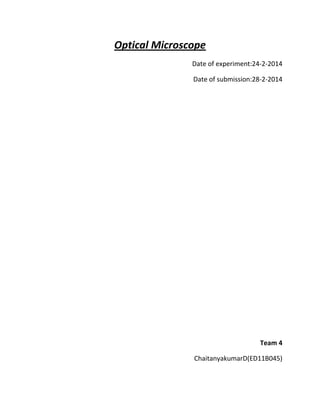
Medical dissection lab optical microscope
- 1. Optical Microscope Date of experiment:24-2-2014 Date of submission:28-2-2014 Team 4 ChaitanyakumarD(ED11B045)
- 2. Abstract: To disassemble an optical Microscope, identify and study it’s various parts, identify its specific function, understand the various working mechanisms and to re assemble the optical microscope again. Introduction:The optical microscope, often referred to as the "light microscope", is a type of microscope which uses visible light and a system of lenses to magnify images of small samples. Optical microscopes are the oldest design of microscope and were possibly invented in their present compound form in the 17th century. Basic optical microscopes can be very simple, although there are many complex designs which aim to improve resolution and sample contrast.The image from an optical microscope can be captured by normal light-sensitive cameras to generate a micrograph. Originally images were captured by photographic film but modern developments in CMOS and charge-coupled device (CCD) cameras allow the capture of digital images. Purely digital microscopes are now available which use a CCD camera to examine a sample, showing the resulting image directly on a computer screen without the need for eyepieces.Alternatives to optical microscopy which do not use visible light include scanning electron microscopy and transmission electron microscopy. Tools used :Screw drivers of appropriate sizes. Experimental Procedure:Remove the illuminator.Disassemble the parts of the optical microscope – The stage, the eye piece, the objective lens, and the rack and pinion mechanisms.Study the function of each part and identify the mechanism and working.Re assemble the parts. Product decomposition : Parts Functions Ocular Lenses These eyepieces further magnify the image formed by the objective lens. It does not improve resolution. They make up an adjustable binocular system. The magnification of the oculars is 10X. They are equipped with a pointer inside one of the lenses which makes it easier to point out specific structures or determine the real dimensions of the
- 3. specimen you are observing. Objective Lenses There is more than one objective lens. These are the primary lenses of a compound microscope and can have magnification of 4x, 5x, 10x, 20x, 40x, 50x and 100x. The magnification values are written on the side of each lens. The objective turret, to which these lenses are attached, can be rotated with hand to get the lens of desired magnification to focus on the object. Arm Connects to the base and supports the microscope head. It is also used to carry the microscope. Stage It is the platform below the objective lens on which the object to be viewed is placed. There is a hole in the stage through which light beam passes and illuminates the specimen that is to be viewed. Light Intensity knob Light on/off switch and intensity knob. Controls the intensity of the light coming from the bulb. Fine Focus Adjustment Knob Controls precise focusing of the object. Only the fine adjustment knob should be used with the high magnification lenses - high power and the oil immersion objective lenses. Moving the fine adjustment knob also helps you to determine the third dimension (depth) of the specimen you are studying. Coarse Focus Adjustment Knob This is used for rapid (or coarse) focusing on the specimen when using the scanning objective lens and the low power lens. This course focusing knob is rotated until the specimen is roughly in focus and then left alone. Stage Clips There are two stage clips one on each side of the stage. Once the slide containing the specimen is placed on the stage, the stage clips are used to hold the slide in place.
- 4. Base The bottom of the microscope Diaphragm It is located on the lower surface of the stage. It is used to control the amount of light that reaches the specimen through the hole in the stage. Component hierarchy:
- 5. Function structure: light energy hand force specimen Geometric layout: Optical microscope Light Display specimen Viewing mechanism Specimen stage and objective lens illuminator
- 6. History: The Dutch spectacle-maker Zacharias Janssen is sometimes claimed to have invented it in 1590 (a claim made by his son and fellow countrymen, in different testimony in 1634 and 1655) Another claim is that Janssen's competitor, Hans Lippershey, invented the compound microscope. Another favorite for the title of 'inventor of the microscope' was Galileo Galilei. He developed an occhiolino or compound microscope with a convex and a concave lens in 1609. Galileo's microscope was celebrated in the AccademiadeiLincei in 1624 and was the first such device to be given the name "microscope" a year later by fellow Lincean Giovanni Faber. Faber coined the name from the Greek words μικρόν (micron) meaning "small", andσκοπεῖ ν (skopein) meaning "to look at", a name meant to be analogous with "telescope", another word coined by the Linceans.Christiaan Huygens, another Dutchman, developed a simple 2- lens ocular system in the late 17th century that was achromatically corrected, and therefore a huge step forward in microscope development. The Huygens ocular is still being produced to this day, but suffers from a small field size, and other minor problems. Possible Improvements:A small camera and a screen can be attached to view the specimen on the screen instead of viewing in the eye piece directly.A powered mechanism to operate the rack and pinion in the stage to hold and move the specimen according to our requirement. Conclusion:In this experiment, we disassembled an optical microscope and assembled it back again. In the process, through reverse engineering, we identified the various parts and understood its functions and mechanisms. Only the screw driver was used. The various modules were identified and various functional and conceptual diagrams were drawn. This improved our understanding about the process